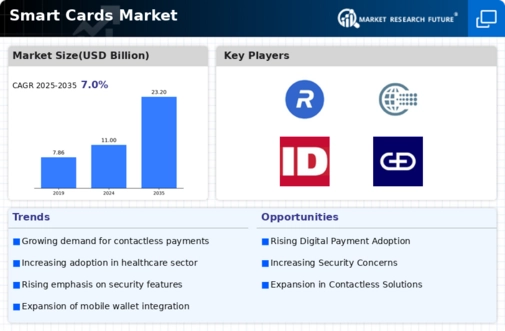Market Analysis
In-depth Analysis of Smart Cards Market Industry Landscape
The Smart Cards market is marked by dynamic and multifaceted market dynamics that shape its growth and evolution. One prominent dynamic is the increasing demand for secure and convenient payment solutions. As digital transactions become more prevalent, the need for advanced security features, such as encryption and authentication, drives the adoption of smart cards across various industries, particularly in banking and finance. This demand is fueled by the rising awareness of the importance of data security in an interconnected world.
Technological advancements play a pivotal role in the market dynamics of Smart Cards. The continuous evolution of smart card technology, including the integration of contactless and near-field communication (NFC) capabilities, expands the applications of smart cards beyond traditional payment systems. This technological progression not only enhances user convenience but also fosters innovation in sectors like healthcare, transportation, and access control systems. As smart cards become more versatile, their market dynamics are influenced by the exploration of new use cases and industries.
Global economic factors significantly impact the Smart Cards market. Economic growth, consumer spending patterns, and overall financial stability influence the adoption rate of smart cards. In times of economic prosperity, businesses and consumers are more willing to invest in advanced payment technologies, contributing to the market's expansion. Conversely, economic downturns may lead to cautious spending, affecting the growth trajectory of the Smart Cards market.
Government regulations and initiatives play a crucial role in shaping the market dynamics of Smart Cards. Regulatory frameworks related to data security, privacy standards, and compliance requirements impact the adoption of smart cards across various industries. As governments worldwide emphasize the importance of secure payment methods and data protection, businesses are compelled to adhere to these regulations, driving the demand for smart cards as compliant solutions.
Competitive dynamics within the Smart Cards market are characterized by the presence of key players, constant innovation, and strategic partnerships. Established companies vie for market share through differentiation, offering unique features and functionalities in their smart card solutions. Continuous innovation is essential for staying competitive, as companies that can introduce cutting-edge technologies gain a distinct advantage. Strategic partnerships with other businesses, financial institutions, or technology providers can provide additional avenues for market expansion and growth.
Consumer preferences and behaviors are key market dynamics influencing the Smart Cards market. As consumers increasingly prefer cashless transactions and prioritize secure payment methods, the demand for smart cards rises. User-friendly interfaces, customization options, and seamless integration into daily life contribute to the acceptance of smart cards among consumers. Understanding and adapting to these evolving preferences are critical for companies seeking to navigate the ever-changing dynamics of the Smart Cards market.
Environmental considerations and sustainability are emerging as influential market dynamics. With growing awareness of environmental issues, consumers and businesses are placing emphasis on eco-friendly materials and manufacturing processes in smart card production. Companies that prioritize sustainability in their offerings can appeal to a conscientious consumer base and gain a competitive edge in the market.






Leave a Comment